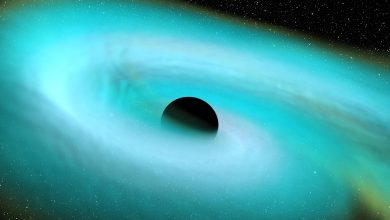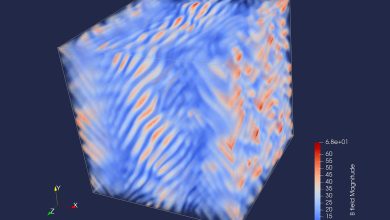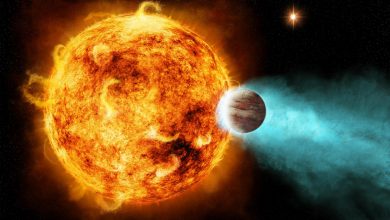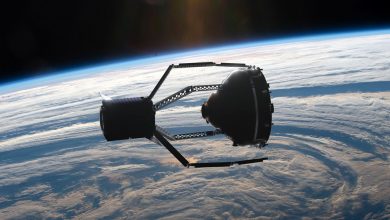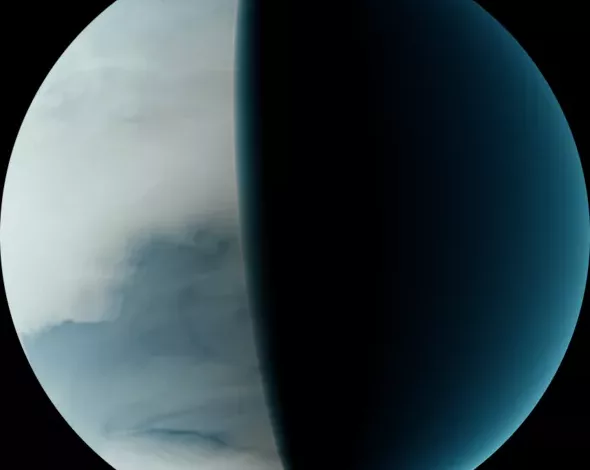
Lead image: An image of Venus taken by the infrared camera on the Japan Aerospace Exploration Agency spacecraft Akatsuki on Sept. 5, 2016. (Image credit: Japan Aerospace Exploration Agency (JAXA))
There are many strange things happening on Venus. Among them is a recognizable weather pattern that scientists now realize has persisted in the planet’s atmosphere for at least 30 years.
Nicknamed the “Giant Dark Cloud,” scientists first noticed that feature in data gathered by an infrared camera aboard the Japanese spacecraft Akatsuki, which has been orbiting Venus since 2015. The cloud is huge, spanning a third of the planet’s latitude around its equator. After identifying the feature, scientists went looking for it in archives of similar infrared observations of the planet and found its signature across the full three decades’ worth of relevant data.
“Cloud physics is something that typically operates on very short timescales,” Kevin McGouldrick, a planetary atmospheric scientist at the Laboratory for Atmospheric and Space Physics at the University of Colorado Boulder and lead author of new research on the phenomenon, told Space.com.
To observe a feature which persists for decades or centuries is weird,” he said. “With a planetary atmosphere, change is the natural environment. If something is persistent, that’s what’s eye-catching.”
Consider his eye caught.
The Giant Dark Cloud feature has two aspects to it, McGouldrick noted. “Initially, this was called a ‘disruption.’ It was recognized as a sharp transition from light to dark that was fairly repeatable,” he said. That transition unfolded over only a couple of degrees of longitude, although it stretches from the equator about 30 degrees latitude north and south. “But then there also was this massive structure behind it, almost hemisphere-size scale” — hence the name.
The whole thing also seemed to orbit differently from the rest of Venus’ weather, lopping the planet once every five days, a few days more rapidly than what McGouldrick called “background clouds.”
But while the Giant Dark Cloud was first identified in data gathered by the Akatsuki orbiter, that spacecraft wasn’t well-positioned to crack the feature’s secrets.
The probe spends most of its time fairly far from the planet to see essentially a full-hemisphere view centered on the equator. And Akatsuki doesn’t carry the crucial device called a spectrometer that allows scientists to analyze light’s fingerprint and determine what ingredients a feature like a strange cloud is made of.
“Trying to understand what it was was tricky with just the Akatsuki data,” McGouldrick said. The feature “kept appearing repeatedly, had fairly similar morphology, [and] we could track how it was moving around the planet,” he said. “But exactly what was changing across that boundary was really hard to pin down.”
And although astronomers have spotted the Giant Dark Cloud in scattered observations from Earth beginning in 1986, those sightings haven’t been consistent enough to allow scientists to piece together the cloud’s story either, McGouldrick said. “They saw it sometimes, they didn’t see it other times, and there was no real rhyme or reason because the observations were very sporadic.”

Consult another spacecraft
So McGouldrick and his colleagues decided to look for potential observations of the strange feature in data gathered by the Venus Express mission, which studied the planet for the European Space Agency (ESA) between 2006 and 2014.
On that spacecraft was an instrument called the Visible and Infrared Thermal Imaging Spectrometer (VIRTIS). That instrument, like the Akatsuki device that helped scientists discover the Giant Dark Cloud, could see infrared light, but it can also complete the chemical analysis missing in the Akatsuki data.
In a new paper based on that work, McGouldrick and his colleagues use the Venus Express data to attempt to understand what’s happening on either side of the sharp transition. So far, the scientists have only analyzed a few chunks of that data, but McGouldrick said they’re starting to piece together a picture of what’s changing as first the front and then the cloud behind it come through.
For example, the feature appears to affect proportions of sulfuric acid and water vapor in the clouds, as well as how low the clouds reach and how large the particles in the clouds are, he said.
In addition to analyzing more VIRTIS data, McGouldrick said he and his colleagues hope that another type of measurement will become feasible in the near future, one that scientists use to understand the size of particles in a particular column of the atmosphere. That type of measurement relies on work scientists are chipping away at to address an ongoing instrument glitch on Akatsuki, the latest step of which was published after McGouldrick’s research was underway.
On Venus and on Earth
Although the Giant Dark Cloud is striking in infrared observations gathered at a distance from Venus, a human somehow able to withstand the harsh conditions at the planet’s surface likely wouldn’t notice a difference when the cloud passed overhead, McGouldrick said, comparing how Venus’ surface would appear to human eyes to the smokey scenes that wildfires are making a common occurrence.
“It is a very limited landscape, it’s a very uniform brightness, and it’s because you have this uniform scattered light in all directions,” he said. “You end up with this pallid, similar color in all directions and that’s likely what it would look like most of the time, if you were to stand on the surface of Venus with the visible light receptors in your eyes.”
The scene might be more interesting with infrared vision. In this scenario, the view from the surface of Venus during the planet’s night might resemble a disco hall, with a deep, dark night sky and a super-bright ground, perhaps with clouds — giant and dark or otherwise — reflecting some of that infrared light back down from above, McGouldrick said.
Whatever the Giant Dark Cloud looks like in person, studying it from a distance may help scientists better understand phenomena in Earth’s atmosphere as well, McGouldrick said. “[Venus] really is, in a lot of ways, the most Earthlike planet we know of other than the Earth,” he said. “At the same time, it is so dramatically different than the Earth in so many ways.”
The atmosphere is just one area where the similar-yet-different characteristics are striking. For example, McGouldrick said that while he and his colleagues aren’t sure yet what phenomenon causes the Giant Dark Cloud, their current hunch is that it’s related to a large-scale atmospheric feature called a Kelvin wave.
Scientists already know of such a wave acting at a higher altitude in Venus’ atmosphere, he said. And Kelvin waves occur in Earth’s atmosphere as well — such a structure is involved in the complicated dynamics behind the El Niño and La Niña weather patterns, for example — but on Earth, local weather is so dynamic that larger phenomena are difficult to spot.
“These do occur on Earth; they’re a little bit harder to recognize,” McGouldrick said. “On Venus, they’re a lot more obvious.” The commonality may mean that studying the Venusian atmosphere will help scientists better understand Earth’s as well.
And for a planet as under-studied as Venus, even being able to recognize a stable atmospheric feature is a step forward.
“Just being able to recognize these repeating patterns is the biggest part of this,” McGouldrick said. “Without recognizing these, we can’t really understand what’s going on on this planet. Now that we see this, we have something to study, we have something to analyze.”
The research is described in a paper published Aug. 6 in The Planetary Science Journal.


